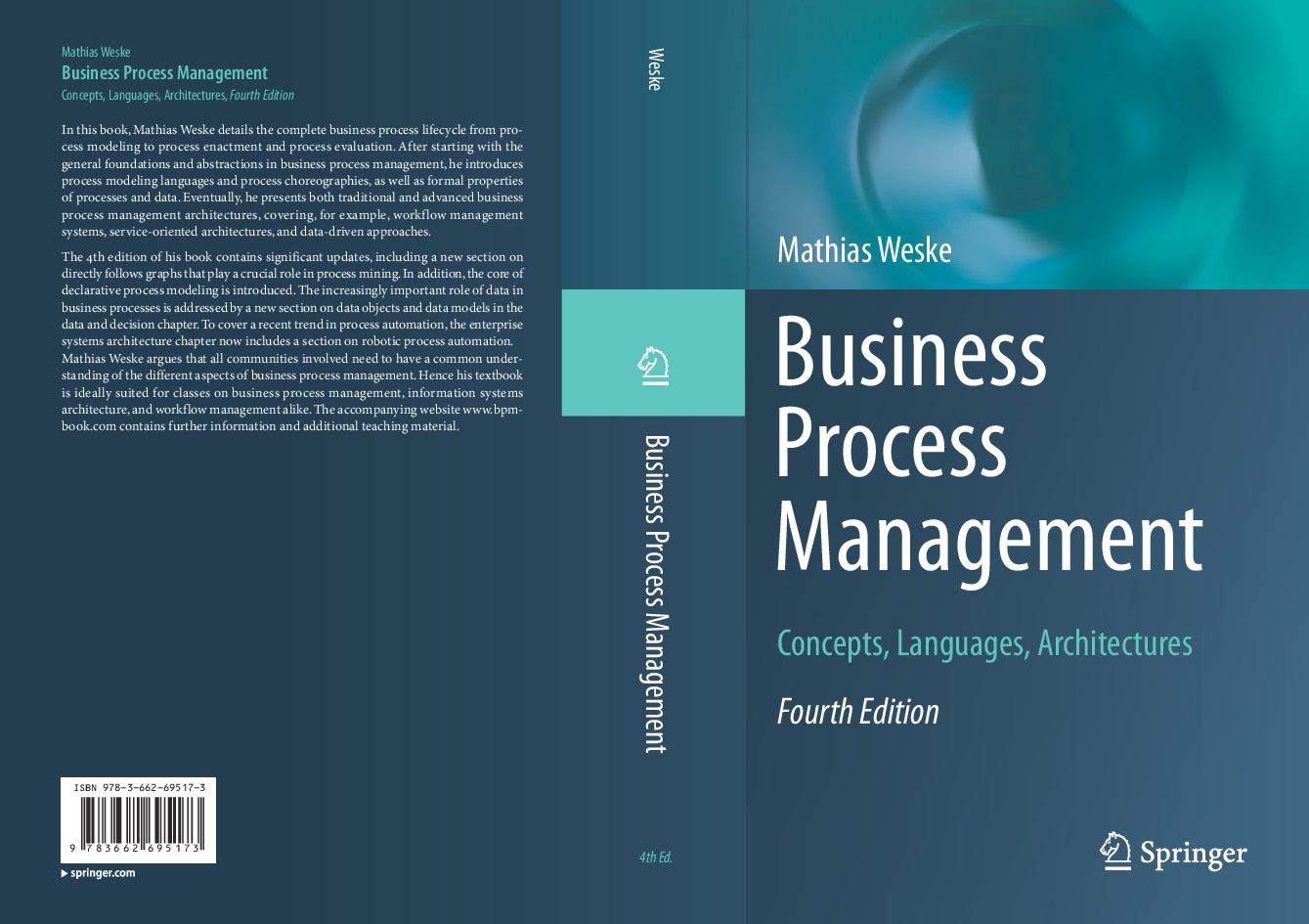Business Process Management: Concepts, Languages, Architectures (Fourth Edition)
Mathias Weske: Business Process Management: Concepts, Languages, Architectures. 4th ed. 2024, Hardcover ISBN 978-3-662-69517-3. eBook ISBN 978-3-662-69518-0. © Springer-Verlag Berlin Heidelberg 2024, Springer Link
A Personal Note to the Fourth Edition
Dear Readers,
The fourth edition of the BPM book was published in July 2024; the main changes are as follows.
- To reflected the increasing importance of directly follows graphs in process mining, I added a section on DFGs in Chapter 4. This chapter is now called Process Modelling Languages, which is more precise than the original title Process Orchestrations, since DFGs are not used for orchestrating processes, but for modeling their execution.
- A stronger focus on data in business processes has led to me writing a new section called Data in Business Processes in Chapter 5. That section provides a link from data objects in process diagrams to UML class diagrams and to object lifecycles. Introducing variables to BPMN data objects allows us to represent multiple data objects of the same class in a given process, which is useful in many real-world scenarios. This section will hopefully provide a solid basis for a more object-centric perspective on business processes.
- Declarative process models allow the compact representation of flexible behaviour using rules. The key idea of declarative process modeling is discussed in the chapter on process modeling languages, and we show that declarative constraints can express typical flexible process behaviour that is hard to represent in imperative process models, such as BPMN process diagrams.
- Robotic process automation is a light-weight automation technology that uses user interfaces of existing applications to automate tasks in business processes. In the chapter on enterprise systems architectures I have added a section on RPA that discusses this new technology from a conceptual and from an architectural perspective.
- As always, there are many minor updates to fix errors and to improve the readability of the BPM book.
- Special thanks to Wil van der Aalst for his remarks on the section on directly follows graphs and for his updated foreword. I truly enjoyed the discussions with Artem Polyvyanyy on directly follows graphs. Tijs Slaats took a detailed look on the section on declarative process modeling, thanks, Tijs! In addition I thank the members of the business process technology research group at HPI for their support.
Mathias Weske
Potsdam, June 24, 2024
A Personal Note to the Third Edition
Dear Readers,
The third edition of the BPM book has been published in June 2019; the main changes are as follows.
- I added a new chapter on business decision modeling, which has emerged as an important topic in business process management recently. After a motivating section, the Decision Model and Notation (DMN) is introduced, which allows us to represent business decisions on different levels of abstraction. Decision tables are investigated in detail, since these allow us to express decision logic in a formally precise, yet well understandable manner.
- I significantly updated the chapter on process choreographies. Conversation diagrams that are hardly used in practice have been removed. The chapter is now much clearer and several imprecisions have been corrected.
- I extended the chapter on properties of business processes to include decisions in business processes. In particular, I added the decision soundness criterion that takes into account decision logic during formal verification of business processes. The definition of relaxed soundness is now much more concise and elegant.
- I introduced new references in decision modeling, and I updated references throughout the book.
- Of course, I corrected all errors that we found in the second edition of the BPM book.
Thanks and happy reading!
Mathias Weske
Potsdam, January 28, 2020
